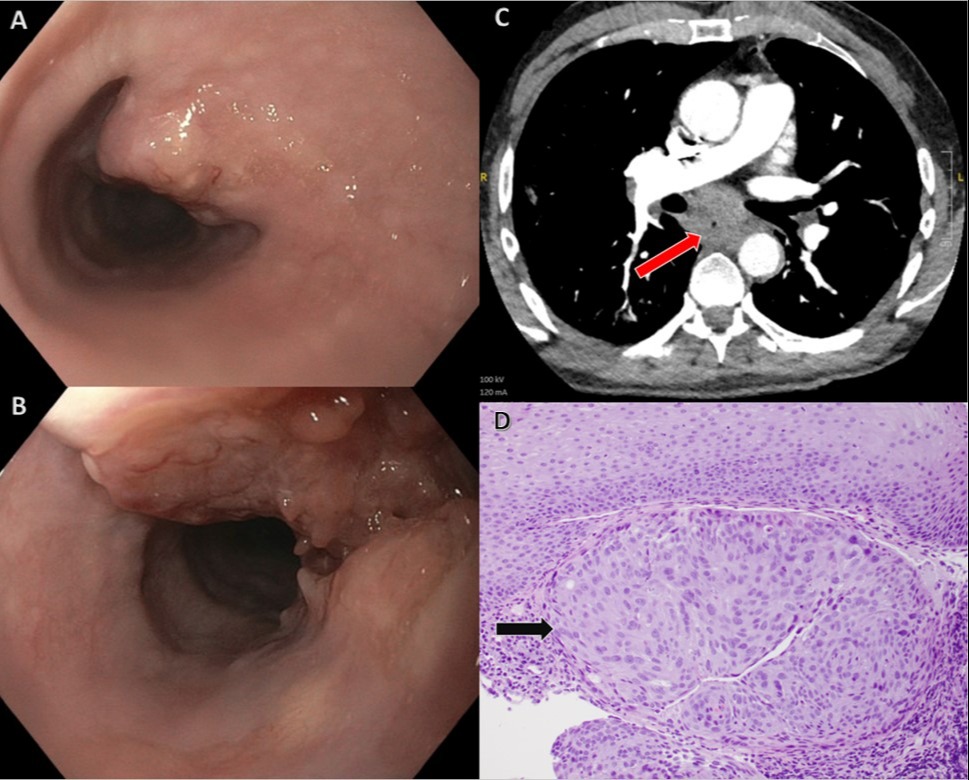Back
Poster Session E - Tuesday Afternoon
E0229 - A Rare Presentation of Esophageal Squamous Cell Carcinoma Presenting as a Paraneoplastic Syndrome
Tuesday, October 25, 2022
3:00 PM – 5:00 PM ET
Location: Crown Ballroom

Samantha Rollins, DO
St. Luke's University
Bethlehem, PA
Presenting Author(s)
Samantha Rollins, DO1, Brian Kim, DO2, Hussam Tayel, MD1, Lisa Stoll, MD, MPH2, Ayaz Matin, MD3
1St. Luke's University, Bethlehem, PA; 2St. Luke's University Health Network, Bethlehem, PA; 3St. Luke's University Hospital, Bethlehem, PA
Introduction: Lambert Eaton myasthenic syndrome (LEMS) is a rare disease of the neuromuscular junction caused by formation of antibodies against voltage-gated calcium channels leading to a constellation of symptoms including muscle weakness, paresthesia, and autonomic dysfunction. LEMS can present as either a paraneoplastic condition or secondary to an autoimmune disorder. Research shows that 60% of cases have an associated malignancy of which more than half are small cell lung cancer. Although LEMS has been associated with other malignancies, no prior cases have been reported with esophageal malignancy. We present a patient with symptoms of LEMS due to esophageal squamous cell carcinoma (SCC).
Case Description/Methods: A 59-year-old male with a history of GERD and hyperlipidemia presented with bilateral paresthesia and progressive weakness of his distal extremities for approximately one month, as well as new onset shortness of breath and a left-sided facial droop. After CVA was ruled out, he was admitted for possible Miller-Fischer variant of Guillain-Barre Syndrome and was started on treatment with IVIG. However, a CTA of the chest obtained on presentation demonstrated short-segment wall thickening of the mid-esophagus suggestive of esophagitis or possible underlying mass. Based on this finding, a paraneoplastic panel was ordered, and the patient underwent endoscopic evaluation. EGD revealed a single fungating ulcerated mass in the mid-esophagus covering one-third of the circumference. Biopsies demonstrated moderately differentiated squamous cell carcinoma. Results of the paraneoplastic panel were positive for P/Q-type calcium channel binding antibody. These findings indicated that the patient’s symptoms were due to a paraneoplastic condition consistent with LEMS in the context of a newly diagnosed esophageal SCC.
Discussion: An extensive review of the literature found no previously reported cases of esophageal SCC associated with LEMS. A comprehensive evaluation of our patient found no other synchronous malignancies that would account for the paraneoplastic process. Although exceedingly rare, this case indicates a potential correlation between esophageal squamous cell carcinoma and P/Q-type VGCC antibodies resulting in LEMS. Current research suggests that up to 80% of patients present with paraneoplastic symptoms prior to any indication of cancer. Therefore, early recognition of possible paraneoplastic syndrome in patients is paramount to facilitate a timely evaluation for underlying malignancy.

Disclosures:
Samantha Rollins, DO1, Brian Kim, DO2, Hussam Tayel, MD1, Lisa Stoll, MD, MPH2, Ayaz Matin, MD3. E0229 - A Rare Presentation of Esophageal Squamous Cell Carcinoma Presenting as a Paraneoplastic Syndrome, ACG 2022 Annual Scientific Meeting Abstracts. Charlotte, NC: American College of Gastroenterology.
1St. Luke's University, Bethlehem, PA; 2St. Luke's University Health Network, Bethlehem, PA; 3St. Luke's University Hospital, Bethlehem, PA
Introduction: Lambert Eaton myasthenic syndrome (LEMS) is a rare disease of the neuromuscular junction caused by formation of antibodies against voltage-gated calcium channels leading to a constellation of symptoms including muscle weakness, paresthesia, and autonomic dysfunction. LEMS can present as either a paraneoplastic condition or secondary to an autoimmune disorder. Research shows that 60% of cases have an associated malignancy of which more than half are small cell lung cancer. Although LEMS has been associated with other malignancies, no prior cases have been reported with esophageal malignancy. We present a patient with symptoms of LEMS due to esophageal squamous cell carcinoma (SCC).
Case Description/Methods: A 59-year-old male with a history of GERD and hyperlipidemia presented with bilateral paresthesia and progressive weakness of his distal extremities for approximately one month, as well as new onset shortness of breath and a left-sided facial droop. After CVA was ruled out, he was admitted for possible Miller-Fischer variant of Guillain-Barre Syndrome and was started on treatment with IVIG. However, a CTA of the chest obtained on presentation demonstrated short-segment wall thickening of the mid-esophagus suggestive of esophagitis or possible underlying mass. Based on this finding, a paraneoplastic panel was ordered, and the patient underwent endoscopic evaluation. EGD revealed a single fungating ulcerated mass in the mid-esophagus covering one-third of the circumference. Biopsies demonstrated moderately differentiated squamous cell carcinoma. Results of the paraneoplastic panel were positive for P/Q-type calcium channel binding antibody. These findings indicated that the patient’s symptoms were due to a paraneoplastic condition consistent with LEMS in the context of a newly diagnosed esophageal SCC.
Discussion: An extensive review of the literature found no previously reported cases of esophageal SCC associated with LEMS. A comprehensive evaluation of our patient found no other synchronous malignancies that would account for the paraneoplastic process. Although exceedingly rare, this case indicates a potential correlation between esophageal squamous cell carcinoma and P/Q-type VGCC antibodies resulting in LEMS. Current research suggests that up to 80% of patients present with paraneoplastic symptoms prior to any indication of cancer. Therefore, early recognition of possible paraneoplastic syndrome in patients is paramount to facilitate a timely evaluation for underlying malignancy.

Figure: Figure: Upper endoscopy demonstrates single fungating ulcerated mass in mid-esophagus (A,B). CT imaging shows thickening of mid esophagus concerning for malignancy (arrow) (C). Esophageal biopsy significant for benign squamous mucosa (top) with underlying squamous cell carcinoma (arrow) (20X, H&E) (D).
Disclosures:
Samantha Rollins indicated no relevant financial relationships.
Brian Kim indicated no relevant financial relationships.
Hussam Tayel indicated no relevant financial relationships.
Lisa Stoll indicated no relevant financial relationships.
Ayaz Matin indicated no relevant financial relationships.
Samantha Rollins, DO1, Brian Kim, DO2, Hussam Tayel, MD1, Lisa Stoll, MD, MPH2, Ayaz Matin, MD3. E0229 - A Rare Presentation of Esophageal Squamous Cell Carcinoma Presenting as a Paraneoplastic Syndrome, ACG 2022 Annual Scientific Meeting Abstracts. Charlotte, NC: American College of Gastroenterology.
